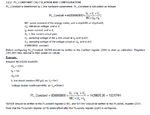hm_fa_da
Full Member level 5
I am developing an Electricity single phase meter which uses ATm90E26 as AFE, there are different registers for gain and offset calibration in the chip, but in Constant configuration formula ( mentioned in m90E26 application note, page 10 ), i think it is wrong ! because it is based on parameters which i have to put in formula like VL and UL ... which are not exact and calibrated !

the formula is:
int(838860800 x (GL x VL x VU) / (MC x Un x Ib ).
MC, Un and Ib are constants and no problem,
but VL and VU are sensitive to hardware which are not same in all devices and boards, all gain and offset calibrations are done to correct these Errors, so i think this formula should take numbers from the result of "after calibration" values not constants calculated by theoretical Voltage Divider Coefficient for example (like the application note sample) !
The device after calibration, shows Voltage and Current and phase angle true in other registers ! so KWh can be calculated by those values, and putting a constant number for frequency of CFx output blinking should be enough for Meter Constant setting !
but why the more and not calibrated parameters like Vl and Vu are required again ?!

the formula is:
int(838860800 x (GL x VL x VU) / (MC x Un x Ib ).
MC, Un and Ib are constants and no problem,
but VL and VU are sensitive to hardware which are not same in all devices and boards, all gain and offset calibrations are done to correct these Errors, so i think this formula should take numbers from the result of "after calibration" values not constants calculated by theoretical Voltage Divider Coefficient for example (like the application note sample) !
The device after calibration, shows Voltage and Current and phase angle true in other registers ! so KWh can be calculated by those values, and putting a constant number for frequency of CFx output blinking should be enough for Meter Constant setting !
but why the more and not calibrated parameters like Vl and Vu are required again ?!
